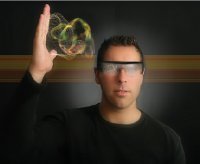The Banker looks at the top 10 emerging technologies that have the potential to transform the planet - from wireless electricity to anaerobic digesting. Writer Michelle Price
Truly transformative technologies emerge only a few times a century. The internet has undoubtedly proved one such consciousness-changing innovation, reshaping as it has the human perception of information, communication, space and time. Few, if any, current innovations can stand up to this revolutionary technology, but the innovations displayed here underline an inescapable truth: the internet and the information it houses was just the beginning.
From 2D bar codes to Wolfram Alpha and the rise of so-called 'augmented reality', there are many ascendant and potentially radical technologies that would have little purpose without the great cloud of information in the sky - which now dominates both the consumer and corporate worlds. All three technologies attempt to harness the colossal soup of internet-based information and imbue it with relevance by deploying it in a manner that is context-specific. Solid-state storage, meanwhile, offers a breakthrough in the mechanism by which that information may be stored, retrieved and consumed by a server.
Elsewhere in these pages, space is devoted to the environment and the high-tech solutions that may address the greatest twin challenges confronting the human race: climate change and energy security.
Thanks to the digital revolution, the worlds of the high-tech and IT are found blended here in the advent, for example, of the much-anticipated smart grid.
Perception-changing technologies designed to alter the way humans conceive of and deploy everyday resources are also profiled, with IBM's emerging suite of water-management technologies a poignant reminder of just how badly man has neglected his most precious resource.
Predicting technological revolutions is a tricky and thankless task and once super-hyped innovations frequently fizzle into obscurity, but not before they are decried as irrelevant, harmful, or simply phony. Despite these hazards, The Banker is profiling 10 emerging technologies that have the potential to transform both the world and man's interaction with it over the next few years.
Wireless electricity
Cutting the corporate loose
The concept of wireless power transmission is not new. Yugoslavian-born physicist and engineer Nikola Tesla explored the concept of wireless electricity transmission in 1892. His backer, one JP Morgan, pulled the plug on Tesla's key project, however, failing to see the business case for transmitting free power to the citizens of New York. Summer 2009, however, saw the first demonstration of the use of wireless electricity in an everyday context. At the Technology, Entertainment, Design (TED) global conference in Oxford last July, US firm WiTricity demonstrated a system that delivers power to devices such as televisions and mobile phones, without the need for wires.
The system, which is able to wirelessly transfer power over a distance of many metres, uses research led by physicist Marin Soljacic at the Massachusetts Institute of Technology and is based on the principle of 'resonance': if two objects have the same resonant frequency they are able to exchange energy. The WiTricity system exploits the resonance of low-frequency electromagnetic waves using two coils engineered to have the same resonant frequency. One coil is plugged into the power mains and could, for example, reside in the ceiling or in the wall. The other is situated in the device. The coil connected to the main electricity supply creates a magnetic field that resonates with that of the second coil, automatically allowing energy to flow between the two. Texas Instruments and Intel are reportedly working on similar technology.
The system could transform the workplace by replacing miles of expensive and often power-inefficient cables while rendering the humble battery all but redundant. Though still in its infancy, wireless electricity already boasts its own industry body, the Wireless Power Consortium which, despite being populated by battery-makers, extols the technology's virtue with vigour: "Let's get rid of the last wire. Why do we still need to plug the power cable in our phones and headsets?" its website asks the curious onlooker. For investment banks, whose energy-intensive trading operations have given rise to a workplace filled with inefficient wires and cables, wireless electricity could bring major operational benefits.
Augmented Reality
Life, but not as we know it
For more than 30 years, tech-heads have dreamt of truly immersive virtual-reality technologies, which will allow humans to design and effortlessly inhabit a three-dimensional virtual fantasy world. But the limitations of the interface technologies have long-confined immersive virtual reality to the realm of science-fiction. Even Second Life, the much-hyped virtual reality website which allows the user to inhabit an alter-ego 'avatar', failed to attract the user-base initially predicted due to the clunky keyboard and screen interface.
Although the problem of creating a virtual reality that truly convinces the senses has yet to be solved, a new technological concept, known as 'augmented reality' (AR), promises to inject elements of virtual reality into the real world. Developed by the military to train fighter pilots, AR comprises a range of technologies that superimpose context-relevant information or images on top of visual stimuli which already exist in the real world.
Take, for example, a mobile device such as an iPhone: the user points the camera of the iPhone at a London high street. Using an AR mobile application already available on the market, the visual display on the device shows not merely the parade of shops, but also additional overlaid information. This digital information, which is stimulated or prompted to appear by the real-life visual information coming through the camera lens, can include reviews of restaurants, arrows pointing to nearby train stations, or additional tourist information on local attractions.
The rise of AR has been made possible by the development of next-generation mobile phones equipped with cameras, global positioning system functions, sensors, high-speed internet connectivity and a digital compass. The implications of the technology for all retailers are far reaching. In early 2009, Dutch bank ING launched the free ING Signpost application for the T-Mobile G1 handset. This helps users to find the closest ATM by overlaying the address of the ATM and directions to it onto a real-time view of the user's surroundings.
Water management
Mapping water architecture
The world is about to confront a global water crisis, as both floods and droughts become increasingly common due to climate change. The growing incidence of flooding globally will dramatically impact corporate risk and inflate insurance premiums, while drought is proving an ever-more prevalent source of regional conflict throughout the world. Fresh water represents just 1% of all the water on earth and, while this volume has never changed, unchecked population growth and immigration - combined with increasing industrialisation and changes in climate patterns - threaten to dramatically alter its chemical composition, distribution and accessibility.
While technologies designed to monitor and predict weather patterns are well established, far less research and development has historically been devoted to understanding and managing global water supplies. This is beginning to change, however. Global technology giant IBM is currently developing a wide-ranging portfolio of water management technologies and software in what the company believes may be a $20bn market by 2015. These technologies include high-tech networks of sensors, so-called 'smart meters', and high-performance data analysis software, designed to analyse water movements, supply and chemical make-up. Emerging water management technologies could alert water companies to leaks, variations in pressure, or the presence of pathogens. From the reservoir to the household sink, communities and regions and even countries could have a single, up-to-date view on the state of the water supply.
In Ireland, a national research infrastructure project dubbed 'SmartBay Galway' is testing cutting-edge water management technologies, using a network of buoys, seafloor cables and other infrastructure that supports a range of sensors, information systems and communication technologies. The project will provide information on riptides, jellyfish schools and other hazards. "Never before has there been a way of doing large-scale marine environment research that allows us to observe ecological phenomena at multiple levels at once," says Dr Peter Heffernan, CEO of Ireland's Marine Institute.
But the technologies will be significant far beyond Galway. They could provide the basis for a global water market or water exchange, as well as providing vital information from which to develop critical risk-mitigation products such as derivatives.
Gesture recognition
Getting physical
For most consumers, the Nintendo Wii home video games console is the most visible and widespread example of gesture-recognition technology: holding a small wireless remote control known as the Wii Remote, the user is able to emulate any number of physical and sporting activities. From golf to dancing, the Wii detects the user's physical gestures and represents them on the screen in the virtual video game environment. The fantastically popular console demonstrates how gesture recognition technology has the capacity to significantly change the way a user interacts with a range of devices, from the television to the PC.
According to Michel Tombroff, CEO of Softkinetic, a provider of three-dimensional gesture-recognition solutions on which user interfaces can be built, gesture-recognition technology has long-been used in robotics and military contexts. But the next generation of gesture recognition technology, which requires no wires, remote controls, or special clothing, is set to move into the mainstream this year. Using a sophisticated mini three-dimensional camera that emits invisible light, all the user's movements can be detected without the need for wires or for the user to be attached to any kind of control or sensors. Similar to sonar, the light emitted by the camera bounces off the user's body. The camera then calculates with sub-second precision the amount of time taken for the light to hit the user's body and return to the camera. This so-called 'time of flight' is then projected onto the screen, allowing the user to freely interact with the virtual world represented in the video game.
Enthusiasts believe that the technology has a range of applications, from assisting in physical rehabilitation programmes and fitness products to minimising the need for a mouse or keyboard. Even the commonplace ATM machine will benefit: with high rates of technical failure due to outside exposure and constant physical contact, the ATM may be transformed by the use of gesture-recognition software. This will allow users to transact with it via specific hand movements that require minimum physical interaction with the appliance.
Solid-state storage
Defying mechanical constraints
Digital storage may reside at the less glamorous end of the IT supply chain but it is nevertheless critical. For data-flooded organisations in the information-based industries such as financial services, managing data storage and retrieval is an ongoing challenge: not only does the exponential growth in data present capacity problems, but it can also adversely affect systems performance. A new form of storage, known as solid-state storage, however, promises to change all this.
Hard disk drives (HDDs), more commonly known as 'hard drives', store digitally encoded data onto rapidly rotating platters with magnetic surfaces. HDDs record or 'write' data by magnetising ferromagnetic material - usually a cobalt-based alloy. The HDD then 'reads' or retrieves the data by detecting the magnetisation of this material: this is the so-called 'read/write' function. The HDD is therefore one of the few remaining areas of the computing world that is still mechanical. This has created an ever-widening performance gap between the HDD and the server: while server performance has dramatically improved over the past 20 years, the system capacity to retrieve information is determined by the speed at which the read/write head is able to move across the magnetic platter. When digital meets analogue, bottlenecks occur and performance slows.
But data storage made from silicon chips instead of spinning metal platters promises to eliminate this gap. Based on so-called 'NAND' flash memory pioneered by Toshiba in the 1980s, solid-state storage uses solid-state electronics as opposed to electromechanical devices. With no moving parts, solid-state drives are less fragile than hard disks and have extremely low levels of latency, meaning input and output rates are far higher than that of HDDs. The cost of solid-state storage has declined dramatically during the past year, meaning it is now positioned for widespread adoption among business users. "Solid-state drives are a breakthrough technology in enterprise information storage that resolve a trade-off IT managers traditionally have to make between performance, availability and cost," says Ken Steinhardt, vice-president and chief technology officer of customer operations at EMC, the storage giant which first introduced solid-state storage to the enterprise IT market in 2008. For speed hyper-sensitive businesses, such as high-frequency trading, solid-state storage will no doubt prove to be another critical technology tool.
Underwater turbines
Harnessing tidal power
Wind power is now the familiar face of the UK's renewable energy programme: as the cheapest and most advanced renewable energy technology on the market, the large-scale installation of wind turbines will play a central role in meeting the UK government's ambitious renewable energy targets. But as an island the UK has a superior source of clean energy: tidal power. Tidal energy is not only plentiful but, unlike wind power, it is predictable and could provide up to 25% of the UK's energy demand if harnessed effectively. But the development of long-bladed underwater turbines technologies, which operate as underwater windmills, has been slow. The world's first tidal-powered turbine was only brought online in Northern Ireland just over a year ago after more than a decade in development.
Despite the challenges, the use of underwater turbines is beginning to grow and there are some radical projects in progress. One of these is being pioneered by US investment bank Morgan Stanley. In October 2008, the bank unveiled plans to build a colossal $400m UK-based onshore data centre near the Scottish coast, powered by tidal energy. Working with Atlantis Resources Corporation, a developer of tidal current turbines in which the bank owns a majority stake, Morgan Stanley proposes to install an array of tidal turbines in Scottish waters, making it the largest tidal energy project globally. The bank hopes to have the first series of tidal blades in operation by 2011.
The next generation of underwater turbines promises to bring similar critical projects. Underwater turbines have traditionally failed due to the harsh and often stormy underwater environment. A Cardiff-based company called Tidal Energy Limited has teamed up with Converteam, a company renowned for designing propulsion systems for ships, to develop a new marine turbine. This should not only prove more robust and efficient but also cheaper to build and maintain. Tidal Energy Limited is testing the new DeltaStream device near Wales and plans to make it fully operational this year.
Two-dimensional bar codes
Decoding data encryption
The bar code is a long-established retail tool familiar to nearly all shoppers globally. Traditionally, the bar code represents item-specific data through the width and spacing of black parallel lines and is often referred to as a linear or one-dimensional (1D) bar code. The rise of two-dimensional bar codes (2D) in recent years has seen this traditional pattern replaced by bar codes comprising squares, hexagons and other geometric, matrix-like patterns which are able to hold far more information than their 1D counterpart.
The technology, which is expected to become widespread throughout US and several Asian markets over the next two years, is already well established in Japan, where it is principally deployed in a business-to-consumer context. The consumer is able to retrieve digital information by using their mobile phone camera as a scanner to read the bar code which then prompts the phone's web browser to pull up relevant information. The code may be placed on a clothing label for example, or a poster, burger box or magazine, offering a far more precise and convenient means of directing consumers to web-based information than the lengthy and often complex web link. As a result, it is more likely to encourage additional online transactions.
For this reason, the 2D bar code has primarily been conceived as a marketing tool, but a number of banks are now printing 2D bar codes on debit cards as an additional security device. When using the card at an ATM or point of sale, the information encrypted in the 2D bar code regarding the customer's personal profile and account status is read by a special card reader and matched against the information on the magnetic strip. In the Philippines, the 2D bar code is being used as a form of contactless payment, with users swiping the 2D bar code to pay for ferry journeys. Mobile phone operators also expect the 2D bar code, which can act as a safe and efficient means of communicating payment information over the air, to underpin the rise of mobile commerce.
Smart grid
Developing intelligent electricity
Frequently described as the internet for power, smart grid technology is expected to revolutionise the way electricity is produced and consumed, bought, sold and distributed.
Today's creaky grid infrastructure was created in the 19th century and is based on analogue principles: as a result, the existing grid is inflexible, vulnerable to outages, and highly centralised. More worryingly, it is not able to accommodate the rise of renewable energy. "If you're using sources of energy that are not predictable you need a much more agile, flexible and adaptive grid," says Colette Lewiner, global energy, utilities and chemicals leader at consultancy Capgemini.
By contrast, smart grid comprises a range of two-way digital technology tools and techniques that will give rise to an intelligent, interactive and flexible grid infrastructure. These include super-conductive transmission lines, the roll-out of intelligent monitoring systems that track all system power flows and an advanced metering infrastructure. Combined, these tools will eliminate 'estimated' bills and allow power generators to develop a sophisticated picture of power consumption patterns. This in turn will allow power companies to influence demand patterns through more sensitive pricing structures: the smart grid could, for example, switch on appliances or factory processes during non-peak hours. In the same way, consumers will also have far greater visibility about energy costs and greater control over their energy consumption. Most importantly, the smart grid technologies will lead to the decentralisation of the grid infrastructure, meaning home generators of power and corporates operating their own micro-generation plants will be able to feed power back into the grid.
The smart grid is being promoted by many governments as a way to enhance energy security, reduce carbon emissions, and improve resilience. The roll-out of smart grid technologies promises to transform the way power is traded and could play in important role in developing a truly sustainable renewable energy market.
Wolfram Alpha
The future of search
Few internet users are unfamiliar with Google, the search engine giant that all but owns the present-day internet. Google radically altered the way users access the kaleidoscope of information available online, but although super-intelligent, it is far from perfect. Users are often presented with a seemingly endless list of information presented in a hierarchical manner that is neither transparent nor immediately relevant to the query.
Wolfram Alpha is a search engine with a difference. Instead of presenting users with an intimidating list, the website generates answers to direct questions by drawing on knowledge contained within a specific, custom-built database. Named after its inventor, British mathematician Stephen Wolfram, the new search engine was hailed, perhaps somewhat over-exuberantly, as a 'Google-killer' when it was first unveiled in May 2009. Unlike Google, all data used in the Wolfram engine comes from trusted sources and is verified by a vast array of subject-matter experts. Mr Wolfram's goal is to develop a search engine that is able to consume free-form input and to generate a precise result presented with maximum clarity: for example, input "square route 25" into the Wolfram Alpha engine and the user is presented not only with the square route of 25, but the visual representation of the full equation.
Because of this, Wolfram Alpha is not so much a search engine as an answer engine acting almost in the manner of a "personal tutor", according to the Wolfram Alpha blog. While still a work in progress, the technology supporting Wolfram Alpha has fascinating implications for the future of search technologies that are able to understand both context and intent. Based on Mr Wolfram's technical computing application, Mathematica, the Wolfram Alpha engine can perform complex calculations on real-time information, such as financial data. The search engine could prove instrumental in improving popular financial literacy and improving the transparency of often complex personal finance products, providing, as it already does, answers to questions on mortgage repayments, interest rates and stock prices.
Anaerobic digesting
Feeding the energy appetite
Energy security is becoming as critical an issue as climate change: outdated, inadequate energy infrastructures combined with the growing scarcity of fossil fuels and the massive underinvestment in renewable energy infrastructure threatens to bring about a yawning energy gap in many developed countries and major financial centres. For IT-intensive, energy-hungry corporates such as banks, this growing gap represents a major business risk. In response, a number of corporates, including several financial services institutions, have begun exploring and developing innovative, technology-led strategies by which to ensure the reliability of their energy supplies and to take control of ballooning energy costs.
The majority of this activity has so far exploited clean or renewable energy resources, with solar power and wind power growing in popularity. Many of these technologies, however, can be awkward to install and often struggle to produce adequate power when deployed onsite. But a form of compost-based power generation, known as anaerobic digestion, promises a more effective means of generating environmentally friendly onsite power generation. An anaerobic digester breaks down organic biomatter, such as waste plant material, producing two by-products: methane and nutrient-rich 'digestate'. The methane can be burned for heat or electricity generation.
London-based data centre operator Infinity is pioneering the use of the anaerobic digester in a non-industrial context. It is soon to become the UK's first operational data centre to be powered entirely using onsite anaerobic digester plant and biomass generators at its campus in East Anglia. The gas is used as fuel for Infinity's combined heat and power plant and can generate up to five megawatts of power, while the fertiliser is returned to local agricultural land. Critically, the anaerobic digester uses waste materials, meaning it does not compete with the food chain, says Martin Lynch, CEO of Infinity. By using biomatter supplied locally and returning the digestate to fertilise local farmland, the entire installation has a tiny carbon footprint and does not degrade the soil composition, explains Mr Lynch, adding: "It's a truly virtuous circle."












